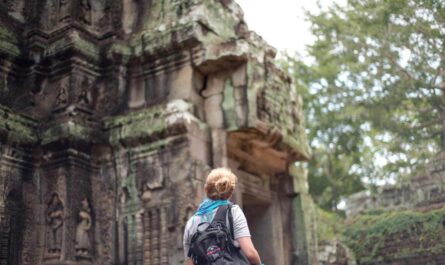What are some of the interesting facts about Tunisia? In recent years, Tunisia has undergone profound political and social transformations, marked by the 2011 Jasmine Revolution that sparked the Arab Spring. Despite the challenges that followed, Tunisia has emerged as a beacon of democracy in the region, with a burgeoning civil society and a commitment to pluralism. As the birthplace of the Arab Spring, Tunisia continues to inspire hope for a more democratic and inclusive future across the Middle East and North Africa. In this article, I will talk about some interesting facts about Tunisia.
Tunisia’s historical significance is palpable, with remnants of Carthaginian, Roman, and Islamic civilizations dotting the landscape. The UNESCO World Heritage Site of Carthage stands as a testament to the once-great Phoenician city, while the majestic ruins of Dougga evoke the grandeur of ancient Rome. Yet, Tunisia is not merely a relic of the past; it is a nation in motion, embracing modernity while honoring its roots.
Interesting Facts About Tunisia: History, Culture, Travel
Nestled along the Mediterranean coast of North Africa, Tunisia is a land of rich history, vibrant culture, and stunning natural beauty. With a tapestry woven from the threads of ancient civilizations, colonial influences, and a modern Arab identity, Tunisia embodies a captivating blend of tradition and progress. From the bustling markets of Tunis to the sun-drenched beaches of Hammamet, the country offers a diverse array of experiences for travelers and locals alike. Here are some interesting facts about Tunisia:
1. Land of Ancient Civilizations: A Tapestry of History
Tunisia, a land nestled along the sun-kissed shores of the Mediterranean, stands as a living testament to the ebb and flow of human civilization. Steeped in history, this enchanting country bears witness to the rise and fall of mighty empires, each leaving an indelible mark upon its cultural landscape. From the Phoenician traders who first ventured ashore to the Carthaginian conquerors who built an empire upon the ruins of ancient Tyre, Tunisia’s past is a tapestry woven with the threads of countless civilizations.
Roman legions marched across its fertile plains, erecting majestic amphitheaters and grandiose villas that still stand testament to their enduring legacy. Islamic scholars and artisans adorned its cities with exquisite mosques and palaces, infusing the land with the beauty of their faith and creativity. Today, Tunisia’s rich heritage serves as a beacon of inspiration, inviting travelers to embark on a journey through time and discover the secrets of its storied past.
2. Carthage: Echoes of a Lost Empire
Carthage, the jewel of ancient North Africa, rises from the sands like a ghostly mirage, its towering ruins bearing silent witness to the glories and tragedies of a bygone era. Once the proud capital of a maritime empire that rivaled Rome itself, Carthage now lies in silent repose, its streets echoing with the whispers of a lost civilization. Among its most iconic landmarks are the ancient city of Carthage, where mighty temples and bustling marketplaces once thrived, and the Baths of Antoninus, a testament to the opulence of its imperial rulers.
As visitors wander among its ruins, they are transported back in time to an age of epic battles, heroic deeds, and larger-than-life personalities, where the fate of nations hung in the balance and the legacy of Carthage was written in blood and stone.
3. Tunis: A Tapestry of Cultures
Nestled along the azure shores of the Mediterranean, Tunis stands as a vibrant mosaic of Arab traditions, French colonial influences, and cosmopolitan charm. As the bustling capital of Tunisia, this historic city beckons travelers with its labyrinthine medina, where narrow alleyways lead to hidden treasures and centuries-old mosques echo with the call to prayer. French colonial architecture lends an air of elegance to its boulevards and squares, while lively souks brim with the sights and sounds of daily life.
From the grandeur of the Bardo Museum to the tranquility of the Kasbah, Tunis offers a wealth of experiences waiting to be discovered. In every corner of the city, the past and present converge, creating a tapestry of cultures that reflects the diverse heritage of Tunisia and the enduring spirit of its people.
4. Embracing Tradition: Tunisian Attire
In Tunisia, traditional dress serves as a vibrant reflection of the nation’s rich cultural heritage and diverse influences. Men often don the Jebba, a loose-fitting tunic characterized by its flowing fabric and intricate embroidery, providing both comfort and elegance in equal measure. Meanwhile, women adorn themselves with a kaleidoscope of colorful fabrics, draping themselves in vibrant scarves, shawls, and dresses that capture the essence of Tunisian style.
From the bustling markets of Tunis to the sun-drenched streets of coastal villages, traditional attire serves as a timeless expression of identity and belonging, honoring age-old customs and celebrating the beauty of Tunisia’s multicultural tapestry.
5. Empowering Minds: Tunisia’s Education Initiative
In Tunisia, education is more than just a pathway to knowledge; it’s a cornerstone of progress, prosperity, and social mobility. Recognizing the transformative power of learning, Tunisia has made education a top priority, investing in initiatives aimed at expanding access and enhancing quality across the nation. From early childhood education to higher learning, Tunisia’s educational system strives to nurture curious minds, foster critical thinking skills, and cultivate a lifelong love of learning among its citizens.
Through innovative programs, teacher training initiatives, and infrastructure development projects, Tunisia is paving the way for a brighter future where every individual has the opportunity to unlock their full potential and contribute to the nation’s growth and development.
6. Unveiling History: The Bardo Museum’s Treasures
Nestled within the historic walls of the Bardo Palace, the Bardo Museum stands as a veritable treasure trove of Tunisia’s rich archaeological heritage, offering visitors a captivating journey through the annals of history. Home to a vast collection of artifacts spanning millennia, the museum showcases Tunisia’s diverse cultural legacy, from ancient Carthage and Roman ruins to Islamic art and medieval treasures.
With its halls adorned with mosaics, statues, and relics from various periods, the Bardo Museum offers a glimpse into the vibrant tapestry of Tunisian civilization, illuminating the stories of the past and inspiring wonder in the hearts of all who wander its hallowed halls. As a custodian of Tunisia’s cultural legacy, the Bardo Museum stands as a testament to the enduring legacy of a nation steeped in history, heritage, and artistic expression.
7. The Essence of Hospitality: A Warm Tunisian Welcome
In Tunisian culture, hospitality is not just a custom but a cherished value that permeates every aspect of daily life. Visitors to Tunisia are greeted with genuine warmth and generosity, welcomed into homes and businesses alike with open arms and hearty greetings. From the bustling souks of Tunis to the tranquil villages nestled amidst olive groves and vineyards, hospitality is the hallmark of Tunisian society, reflecting a deep-seated belief in the importance of kindness, generosity, and mutual respect. Whether sharing a cup of fragrant mint tea with strangers or feasting on traditional couscous and grilled meats with newfound friends, visitors to Tunisia are treated to an unforgettable experience that embodies the spirit of hospitality in its purest form.
8. Protecting Precious Wildlife: Tunisia’s Conservation Commitment
Tunisia’s diverse landscapes are home to a wealth of precious wildlife, including endangered species like the Barbary sheep (aoudad) and the Scimitar-horned Oryx. Recognizing the importance of preserving these iconic creatures for future generations, Tunisia has embarked on ambitious conservation efforts aimed at safeguarding their habitats and promoting sustainable coexistence between humans and wildlife.
Through initiatives such as protected areas, wildlife reserves, and community-based conservation projects, Tunisia is working tirelessly to ensure the survival of its most vulnerable species and protect the biodiversity that enriches its natural heritage. By uniting conservationists, policymakers, and local communities in a shared commitment to environmental stewardship, Tunisia is forging a path towards a more sustainable future where humans and wildlife thrive in harmony.
9. The Ghriba Synagogue: A Beacon of Religious Heritage
Perched atop the sun-kissed shores of Djerba Island, the Ghriba Synagogue stands as a timeless testament to Tunisia’s rich tapestry of religious diversity and cultural heritage. Dating back over 2,000 years, this venerable sanctuary is one of the oldest synagogues in the world, revered by Jews and non-Jews alike as a sacred site of pilgrimage and prayer. With its whitewashed walls, azure domes, and ornate mosaics, the Ghriba Synagogue exudes an aura of ancient mystique and spiritual significance, drawing visitors from far and wide to experience its hallowed halls and storied past. As a symbol of Tunisia’s commitment to religious tolerance and interfaith harmony, the Ghriba Synagogue serves as a beacon of hope and unity in a world too often divided by sectarian strife and discord.
10. The Heart of Tunisian Society: Family Bonds
In Tunisia, family is not just a mere social unit but the cornerstone of society, where strong bonds and respect for elders form the foundation of everyday life. From the sprawling metropolis of Tunis to the quaint villages nestled amidst olive groves and vineyards, familial ties are woven into the fabric of Tunisian culture, shaping traditions, values, and communal identity. In Tunisian households, generations come together under one roof, sharing meals, stories, and laughter as they navigate life’s joys and challenges hand in hand.
The wisdom of elders is revered, their guidance sought in matters both mundane and momentous, fostering a sense of unity and belonging that transcends time and space. In a world marked by rapid change and uncertainty, the enduring strength of family provides solace, stability, and a timeless reminder of the bonds that bind us together as one.
11. Embracing Tradition: The Hamam Ritual
In the bustling souks and quiet alleyways of Tunisia, the hamam stands as a sanctuary of tradition, where ancient rituals of cleansing and rejuvenation are preserved and cherished. Dating back centuries, the hamam holds a special place in Tunisian culture, serving as a communal gathering space where friends and family come together to cleanse the body, soothe the soul, and reconnect with tradition.
Stepping into the tranquil confines of the hamam, visitors are enveloped in a cloud of steam and the rhythmic sound of running water, transported to a world where time seems to stand still. As they surrender to the gentle ministrations of skilled attendants, tensions melt away, leaving behind a profound sense of relaxation and renewal. More than just a place to cleanse the body, the hamam embodies the essence of Tunisian hospitality, offering a haven of warmth, tranquility, and communal bonding in an increasingly fast-paced world.
12. The Rhythms of Tunisian Culture: Music’s Melodic Tapestry
In Tunisia, music is not merely a form of entertainment but a vibrant expression of cultural identity, where diverse styles and rhythms reflect the nation’s rich tapestry of heritage and tradition. From the haunting melodies of Malouf, a classical genre steeped in Andalusian influences, to the lively strains of Mezoued, a folk tradition rooted in North African rhythms, Tunisian music captivates the heart and soul with its melodic beauty and emotive power.
Whether performed in bustling marketplaces, intimate cafes, or grand concert halls, music serves as a communal thread that binds together people of all backgrounds, bridging divides and fostering a sense of unity and belonging. As the sounds of Tunisian music fill the air, they evoke a kaleidoscope of emotions, memories, and dreams, weaving a melodic tapestry that celebrates the rich cultural heritage of Tunisia and the enduring spirit of its people.
13. Woven Treasures: Tunisian Carpets
In the vibrant tapestry of Tunisian culture, hand-woven carpets stand as revered symbols of craftsmanship, tradition, and artistic expression. Passed down through generations, these intricate creations embody the rich heritage of Tunisia, with their elaborate designs and vibrant hues reflecting the diverse influences of the region. From the bustling markets of Tunis to the tranquil villages nestled amidst olive groves, Tunisian carpets adorn homes and public spaces alike, adding warmth, beauty, and a touch of elegance to every setting. Crafted with care and precision by skilled artisans, each carpet tells a story of tradition, resilience, and cultural identity, weaving together the threads of history and creativity into a masterpiece that transcends time and space.

14. Sweet Symbols of Tradition: Tunisian Dates
In the sun-drenched lands of Tunisia, dates reign supreme as cherished symbols of abundance, hospitality, and cultural heritage. Revered for their natural sweetness and nutritional value, these succulent fruits have been a staple food in Tunisian cuisine for centuries, gracing tables during festive occasions, religious celebrations, and everyday meals alike.
Beyond their culinary significance, dates hold a deeper cultural meaning in Tunisian society, symbolizing prosperity, generosity, and the blessings of nature. Whether enjoyed fresh, dried, or incorporated into delectable dishes and desserts, dates remain an integral part of Tunisian life, enriching both body and soul with their rich flavor and timeless tradition.
15. Celebrating the Sands: The Chott el Jerid Festival
Each year, amidst the vast expanse of the Tunisian desert, the Chott el Jerid Festival springs to life, offering a vibrant celebration of the unique landscape and cultural heritage of the region. Against the backdrop of shimmering salt flats and endless horizons, locals and visitors alike gather to partake in a spectacle of music, dance, and camel races, breathing new life into the ancient sands.
From the rhythmic beats of traditional drums to the graceful movements of desert dancers, the festival pulsates with energy and excitement, inviting all to revel in the beauty and bounty of the desert. As the sun sets over the horizon, casting a golden glow upon the sands, the Chott el Jerid Festival serves as a poignant reminder of the enduring spirit of Tunisia and the timeless allure of its desert landscapes.
16. Djerba Island: Jewel of the Mediterranean
Nestled off the coast of Tunisia, Djerba Island beckons travelers with its pristine beaches, picturesque villages, and captivating history. As the largest island in North Africa, Djerba exudes an irresistible charm, where azure waters meet golden sands, and palm-fringed oases dot the landscape. Whether exploring the labyrinthine streets of Houmt Souk, immersing oneself in the vibrant colors of the Guellala pottery workshops, or basking in the tranquility of a seaside hammam, visitors are treated to an array of experiences that awaken the senses and soothe the soul. With its rich tapestry of Berber, Arab, and Jewish influences, Djerba Island stands as a testament to the enduring allure of Tunisia’s coastal treasures, inviting travelers to embark on a journey of discovery and delight.
17. El Jem: Timeless Grandeur of the Roman Amphitheatre
In the heart of Tunisia lies a testament to ancient splendor: the Roman Amphitheatre of El Jem. Recognized as a UNESCO World Heritage Site, this majestic coliseum stands as a marvel of engineering and a relic of Tunisia’s storied past. Built in the 3rd century AD, the amphitheater once hosted gladiatorial contests, chariot races, and theatrical performances, echoing with the cheers of spectators and the clash of combatants.
Today, visitors marvel at its towering walls and intricate architecture, marveling at the ingenuity of its builders, and the enduring legacy of Roman civilization. As the sun sets over the sandstone ruins, casting a golden glow upon the ancient stones, El Jem offers a glimpse into the grandeur of a bygone era, where history and heritage converge in timeless harmony.
18. Kairouan: Cradle of Islamic Civilization
Perched on the edge of the Saharan sands, Kairouan stands as a beacon of spirituality and cultural richness in the Tunisian landscape. Revered as one of Islam’s holiest cities in North Africa, Kairouan boasts a heritage that spans centuries, from its majestic mosques and ancient medina to its bustling souks and tranquil courtyards. At the heart of the city lies the Great Mosque of Kairouan, a masterpiece of Islamic architecture and a symbol of faith and devotion for Muslims around the world.
As the call to prayer echoes through its hallowed halls, visitors are transported to a realm where time stands still, and the spirit of Islam permeates every stone and shadow. Beyond its religious significance, Kairouan exudes a timeless charm, where tradition and modernity intertwine to create a tapestry of cultural richness and spiritual enlightenment.
19. Couscous: Tunisian Culinary Tradition
At the heart of Tunisian cuisine lies a beloved staple: couscous. This fragrant dish, crafted from steamed semolina grains, embodies the essence of Tunisian culinary heritage, marrying savory flavors with wholesome ingredients. Whether adorned with succulent lamb, tender chicken, or a medley of seasonal vegetables, couscous serves as a canvas for culinary creativity, reflecting the diverse influences of North African cuisine.
Perfumed with aromatic spices and crowned with a drizzle of olive oil, each bite of couscous transports diners on a journey of sensory delight, evoking memories of family gatherings, festive celebrations, and the warm embrace of Tunisian hospitality.
20. Briouats: Exquisite Pastries of Tunisia
For a taste of Tunisian indulgence, look no further than briouats: delicate pastries that tantalize the taste buds with their crispy exterior and delectable fillings. Whether stuffed with savory blends of spiced meats and herbs or sweet concoctions of almonds, honey, and fragrant spices, briouats offer a symphony of flavors and textures that delight the senses.
Served as a cherished snack or elegant appetizer, these golden parcels of pastry evoke the artistry of Tunisian culinary craftsmanship, showcasing the country’s passion for exquisite flavors and meticulous preparation. With each bite, briouats invite diners to savor the essence of Tunisian cuisine, where every morsel tells a story of tradition, innovation, and culinary delight.
21. Mint Tea: The Elixir of Tunisian Hospitality
In the sun-drenched lands of Tunisia, hospitality is synonymous with a steaming pot of mint tea, whose fragrant aroma and soothing warmth welcome guests with open arms. Brewed with fresh mint leaves, fragrant green tea, and a touch of sugar, mint tea serves as a symbol of friendship, camaraderie, and shared moments of joy. Whether enjoyed in the bustling souks of Tunis, the tranquil courtyards of Kairouan, or the intimate gatherings of family and friends, mint tea transcends mere refreshment to become a cherished ritual, uniting people in moments of connection and conviviality. With each sip, Tunisian mint tea offers a taste of the country’s rich cultural heritage, where tradition, warmth, and generosity intertwine to create moments of pure delight and lasting memories.
22. Star Wars Filming Locations: Tunisian Desert Adventure
Venture into the desolate beauty of the Tunisian desert, where sand dunes stretch to the horizon and ancient ksars whisper tales of bygone civilizations. It’s here, amidst the timeless landscape of Tunisia, that the Star Wars saga found its iconic backdrop. From the dusty plains of Chott el Jerid to the rugged canyons of Matmata, Tunisia served as a cinematic canvas for the adventures of Luke Skywalker, Princess Leia, and Han Solo.
Explore the sun-scorched remnants of Ksar Ouled Soltane, where the Lars homestead stood in the original trilogy, or wander through the troglodyte dwellings of Matmata, which doubled as Luke Skywalker’s childhood home on Tatooine. With each step, immerse yourself in the otherworldly charm of Tunisia’s desert vistas, where fantasy and reality converge to create an unforgettable journey to a galaxy far, far away.
23. Jebel Nefusa: Berber Treasures Amongst the Peaks
Nestled amidst the rugged peaks of Jebel Nefusa, Berber villages cling to cliffsides, preserving a way of life steeped in tradition and resilience. Here, amidst the arid landscapes of western Tunisia, ancient kasbahs and labyrinthine medinas offer a glimpse into a world untouched by time. Wander through the narrow alleys of Gharyan, where whitewashed houses cascade down rocky slopes, or marvel at the terraced fields of Jadu, where olive groves and almond orchards thrive in the mountain’s embrace. With each passing moment, discover the enduring spirit of the Berber people, whose rich cultural heritage is woven into the fabric of Jebel Nefusa, creating a tapestry of beauty, resilience, and ancient wisdom.
24. The Liquid Gold of Tunisia: Olive Oil’s Enduring Legacy
In the sun-drenched groves of Tunisia, olive trees stand as guardians of a cherished tradition: the production of liquid gold known as olive oil. For centuries, Tunisian olive oil has been revered for its exceptional quality and rich flavor, earning it a place of honor in kitchens around the world. From the verdant hillsides of the Cap Bon peninsula to the fertile plains of Sfax, Tunisia’s olive oil industry thrives, fueled by a legacy of craftsmanship and dedication to excellence.
Whether drizzled over crisp salads, used to sauté fragrant spices, or enjoyed as a dipping sauce for freshly baked bread, Tunisian olive oil embodies the essence of Mediterranean cuisine, infusing every dish with its golden hue and velvety texture. As a symbol of prosperity, health, and culinary artistry, olive oil holds a special place in Tunisian culture, where its liquid gold remains an enduring legacy of the land.
25. The Sahara Beckons: A Desert Odyssey
Embark on a journey into the heart of the majestic Sahara Desert, where endless dunes of golden sand ripple like waves frozen in time. In southern Tunisia, the Sahara’s vast expanse unfolds before you, inviting intrepid travelers to discover its secrets. Set out on a desert safari, where skilled guides lead you across shifting sands on camelback, tracing ancient caravan routes steeped in history and legend.
As the sun dips below the horizon, behold a celestial spectacle like no other, as the night sky ignites with a myriad of stars, beckoning you to contemplate the wonders of the universe. From camping beneath a blanket of stars to exploring hidden oases nestled amidst towering dunes, the Sahara promises an unforgettable adventure, where the spirit of exploration and the allure of the unknown converge in a landscape of timeless beauty.
26. Roman Amphitheaters: Relics of Antiquity
Step back in time to the days of the Roman Empire as you behold the grandeur of El Jem and Dougga’s ancient amphitheaters. Magnificent testaments to Rome’s enduring legacy in Tunisia, these colossal structures stand as symbols of power, ingenuity, and architectural mastery. In El Jem, marvel at the imposing silhouette of the third-largest Roman amphitheater in the world, where gladiators once battled amidst roaring crowds. Motivation – Mind – Success – Thinking – Productivity – Happiness
Venture to Dougga, a UNESCO World Heritage Site, and wander among the weathered ruins of an ancient city, where the echoes of Roman civilization resonate through time. From the soaring arches of El Jem to the well-preserved columns of Dougga’s theater, these archaeological wonders offer a glimpse into Tunisia’s rich cultural heritage and the enduring influence of Rome’s imperial past.
27. The Chott el Djerid: A Mirage of Salt and Sunlight
Behold the surreal beauty of Chott el Djerid, a vast salt lake that shimmers like a mirage in the desert’s embrace. Stretching across southern Tunisia, this ethereal landscape captivates the imagination with its otherworldly allure, particularly during the scorching summer months. As temperatures rise, the lake’s crystalline surface appears to dance and shimmer under the blazing sun, creating a mesmerizing spectacle of light and shadow.
Traverse the salt flats, where undulating patterns of salt crystals form intricate mosaics beneath your feet, and marvel at the stark beauty of this natural wonder. Whether witnessing a fiery sunset over the salt lake or gazing upon the moonlit expanse of Chott el Djerid, prepare to be enchanted by the timeless beauty of Tunisia’s desert jewel.



